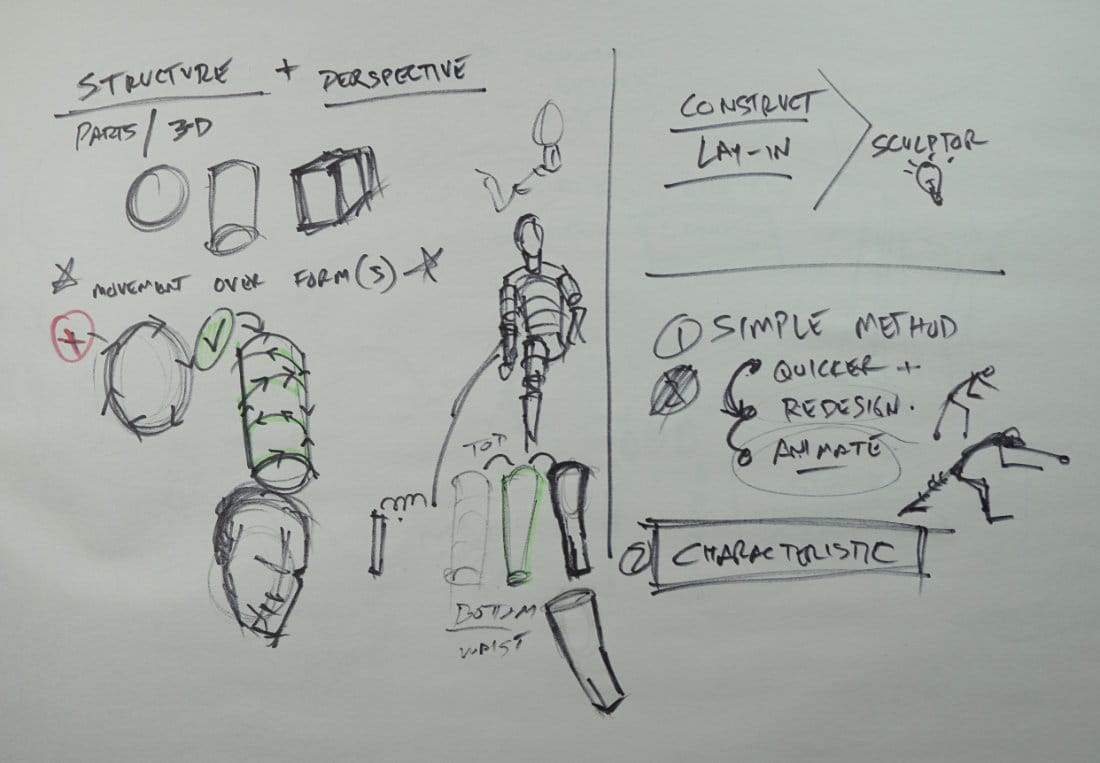Structure Basics for Figure Drawing: Movement Over Form
Structure is about breaking the figure into 3D parts. But there's more to it than just shapes - you need to understand movement OVER the form, not around it. This fundamental shift changes everything about how you draw.

Structure is about breaking the figure into 3D parts. But there's more to it than just shapes - you need to understand movement OVER the form, not around it.
This lesson is part of the Figure Drawing Course - a complete free course teaching you to draw the human body from scratch.
Watch the full lesson:
The Three Basic Shapes
You can draw almost anything with three forms:
1. Circle/Sphere - Basic volume
2. Tube/Cylinder - Direction and axis
3. Cube/Box - Perspective and planes
That's it. Three shapes. Everything else is a modification of these.

Movement Over Form vs Around Form
Here's the key difference most beginners miss:
Around the form = Contour drawing
- You're tracing the edge
- Flat silhouette
- No volume information
- Looks like a cutout
Over the form = Structural drawing
- Lines wrap around the surface
- Shows volume and direction
- Three-dimensional feeling
- Feels like sculpture
Think like a sculptor. They don't think about edges - they think about form, volume, and how surfaces turn in space.
Why Simplification Matters
Using simple 3D shapes gives you three huge advantages:
1. Quick Construction
Once you're fluid, you can lay in an entire pose in seconds. Circle for ribcage, tube for arm, box for pelvis - done.
2. Easy Redesign
Something wrong? Twist the tube, elongate the oval, adjust the cube. Fast fixes without redrawing everything.
3. Exaggeration & Animation
Want more energy? Push the forms further. Thrust that leg out, arch that back, emphasize the gesture. Simple forms let you animate quickly.
This is why you DON'T want to start with contours and details. When you invest time rendering and then realize the gesture is wrong, you're stuck. With simple forms, you redesign in seconds.
Characteristic Shapes
Generic shapes work, but characteristic shapes work better.
Example: The Forearm
Generic: Simple tube
Better: Tapered tube (wider at elbow, narrower at wrist)
Best: Oval at top → tapers → box-like at wrist → curves slightly
The more characteristic your starting shape, the less work you do later.
Starting with a perfect tube for a forearm means more steps to get to realistic. Starting with a characteristic shape gets you 80% there immediately.
The Construction Mindset
Think of this as lay-in work:
- Parts (structure)
- 3D forms (volume)
- Movement over form (not contours)
- Characteristic shapes (accurate from the start)
- Simple method (quick construction and redesign)
You're not trying to finish the drawing yet. You're building the armature that everything else hangs on.
Get the structure right, and the rest flows naturally.
Course Navigation
Part of: Figure Drawing Course > Module 1: Foundation
← Previous Lesson: Structure vs Gesture Figure Drawing
Next Lesson → Gesture Basics
Continue Learning
If you enjoyed this hand drawing course, explore even more lessons on our Free Drawing Tutorials & Courses Hub — including the complete How to Draw – Beginner’s Course.
Want new tutorials delivered to your inbox? Subscribe here and get free lessons, tips, and inspiration sent directly to you.




